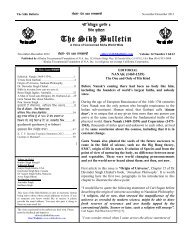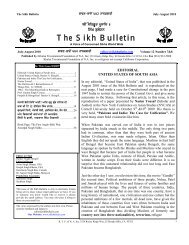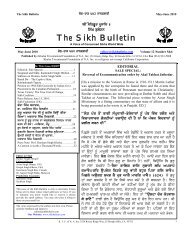You also want an ePaper? Increase the reach of your titles
YUMPU automatically turns print PDFs into web optimized ePapers that Google loves.
<strong>The</strong> <strong>Sikh</strong> <strong>Bulletin</strong> vYswK 537 April 2005<br />
Khalsa Vahiguru jl ki Fateh (Utter, Hail the Khalsa who to<br />
the Lord belongs; the Lord to whom belongs victory)." <strong>The</strong><br />
<strong>Sikh</strong> repeated the blessed utterance. After the five life-giving<br />
draughts had been thus administered, the Guru sprinkled the<br />
holy liquid into his face gazing intently into his eyes. He then<br />
anointed his hair with the nectar. In the same manner, Guru<br />
Gobind Singh initiated the other four one by one. At the end,<br />
all five of them were given the steel bowl to quaff from it<br />
turn by turn the remaining elixir in token of their new<br />
fraternal comradeship. <strong>The</strong>n, following the Guru, they<br />
repeated Vahiguru five times as gurmantra and five times<br />
recited the Mul Mantra. <strong>The</strong>y were given the common surname<br />
of Singh, (meaning lion) and enjoined to regard<br />
themselves as the Khalsa, i.e. the Guru's own. <strong>The</strong>y were<br />
told that their rebirth into this brotherhood meant the annihilation<br />
of their family ties (kul nas), of the occupations<br />
which had formerly determined their place in society (krit<br />
nas), of their earlier beliefs and creeds and of the ritual they<br />
observed. <strong>The</strong>ir worship was to be addressed to none but<br />
Akal, the Timeless One. <strong>The</strong>y were ever to keep the five<br />
emblems of the Khalsa—kesa or long hair and beard;<br />
kangha, a comb tucked into the kesa to keep it tidy in<br />
contrast to the recluses who kept it matted in token of their<br />
having renounced the world; kara, a steel bracelet to be worn<br />
round the wrist of the right hand; kachchha, short breeches;<br />
and kirpan, a sword. In the rahit or code of conduct<br />
promulgated for the <strong>Sikh</strong>s on that day were the four<br />
prohibitions, i.e. the cutting or trimming of hair, fornication<br />
or adultery, halal meat or flesh of animal slaughtered with<br />
the Muslim ritual, and tobacco.<br />
<strong>The</strong> five were designated by Guru Gobind Singh as Panj<br />
Piare, the five beloved of the Guru. He now besought them to<br />
initiate him into their brotherhood, and asked them to prepare<br />
khande di pahul. <strong>The</strong> Panj Piare churned the holy water<br />
following the Guru's example and administered to him the<br />
vows they had received from him. Even his name changed to<br />
(Guru) Gobind Singh. Many <strong>Sikh</strong>s then volunteered to<br />
undergo initiation.<br />
<strong>The</strong> five who took the next turn were Ram Singh, Deva<br />
Singh, Tahal Singh, Ishar Singh and Fateh Singh. <strong>The</strong>y were<br />
called by the Guru Panj Mukte, the Five Liberated Ones.<br />
According to the Guru kian Sakhian, in the next row stood<br />
Mani Ram, Bachittar Das, Ude Rai, Anik Das, Ajab Das,<br />
Ajaib Chand, Chaupat Rai, Diwan Dharam Chand, Alam<br />
Chand Nachna and Sahib Ram Koer, followed by Rai Chand<br />
Multani, Gurbakhsh Rai, Gurbakhshish Rai, Pandit Kirpa<br />
Ram Datt of Mattan, Subeg Chand, Gurmukh Das, Sanmukh<br />
Das, Amrik Chand, Purohit Daya Ram, Barna, Ghani Das,<br />
Lal Chand Peshauria, Rup Chand, Sodhi Dip Chand, Nand<br />
Chand, Nanu Ram of Dilvali, and Hazari, Bhandari and<br />
Darbari of Sirhind.<br />
Khande di pahul thus supplanted charanamrit. Since then<br />
initiation has been by amrit or holy water prepared in the<br />
manner laid down by Guru Gobind Singh. For the novitiates<br />
the same ceremony will be repeated. Panj Piare chosen at<br />
any place for their piety and reputation will officiate, in the<br />
presence of the Guru Granth Sahib attended by a Granthi.<br />
Among the Panj Piare could be women too, as there could<br />
be among the novitiates. No particular age is prescribed for<br />
initiation. It could take place any time the novitiate is able to<br />
appreciate the significance of the ceremony and is prepared<br />
to abide by the discipline it imposed. A patit, an apostate or<br />
lapsed <strong>Sikh</strong> guilty of committing a kurahit, i.e. violation of<br />
any of the prohibitions laid down by Guru Gobind Singh,<br />
will have to go through the same ceremony to have himself<br />
reinitiated and readmitted into the Khalsa fold. Khalsa rahit<br />
or discipline flowing from khande di Pahul has been sought<br />
to be codified in Rahitnamas, manuals of conduct. Some of<br />
these are attributed to Guru Gobind Singh's contemporaries<br />
such as Bhai Daya Singh, Bhai Chaupa Singh and Bhai<br />
Nand Lal.<br />
Directions with regard to the conduct of the amrit ceremony<br />
as issued by the Shiromani Gurdwara Parbandhak<br />
Committee in its publication <strong>Sikh</strong> Rahit Maryada are as<br />
follows:<br />
a) <strong>The</strong> initiation ceremony may be conducted in any quiet<br />
and convenient place. In addition to the Guru Granth<br />
Sahib, presence of six <strong>Sikh</strong>s is necessary: one granthi<br />
to read from the Guru Granth Sahib and five to<br />
administer the rites.<br />
b) Both receiving initiation and those administering it<br />
should bathe and wash their hair prior to the<br />
ceremony.<br />
c) Any <strong>Sikh</strong> who is mentally and physically "whole" (man<br />
or woman) may administer the rites of initiation provided<br />
that he himself had received the rites and continues to wear<br />
the five K's, i.e. <strong>Sikh</strong> symbols each beginning with the<br />
Gurmukhi letter "k".<br />
d) Any man or woman of whatever nationality, race or<br />
social standing, who is prepared to accept the rules<br />
governing the Khalsa community, is eligible to receive<br />
initiation.<br />
e) No minimum or maximum age limit is stipulated for<br />
those receiving initiation.<br />
f) Those undergoing initiation should have the five K's<br />
(unshorn hair, comb, shorts, sword, steel bangle). No<br />
jewellery or distinctive marks associated with other faiths<br />
may be worn. <strong>The</strong> head must be covered.<br />
g) Anyone seeking readmission after having resiled from<br />
his previous pledges may be awarded a penalty by the five<br />
administering initiation before being readmitted.<br />
h) During the ceremony, one of the five Piare ("five loved<br />
ones"—representing the first five <strong>Sikh</strong>s), stands and<br />
explains the main rules and obligations of the Khalsa Panth.<br />
<strong>The</strong> <strong>Sikh</strong> Center Roseville, 201 Berkeley Ave, Roseville, CA. 95678 4
















